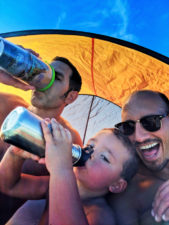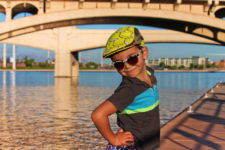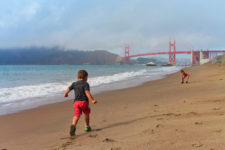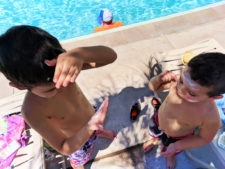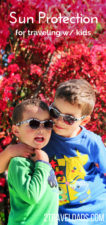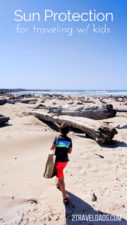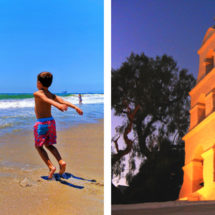Summer is here! Huzzah! We’ve shared before about ways the we keep the kids safe while we’re traveling, including sun protection. You know that we think it’s important to ensure everybody has good information about keeping themselves and their families healthy, but with that know that we’re not advocating any one product, brand of sunblock, or even telling you that you need to be using it, just giving good, solid tips for sun protection while traveling with lots of alternatives to harsh chemicals.
Sun Protection without lotions or skin products
We really don’t like to put sunblock or lotions on our kids or medicate them without due cause, as the human body is a strong machine that comes equipped to handle the elements and interference to a certain point. It’s absolutely true that we will sooner go without sunblock for an outing than lather the kids up with chemicals and goo. Yep, other parents and travelers we meet will quite openly criticize us for this but that’s okay. We are confident in how we look out for our kids (and ourselves) when it comes to sun protection.
So, how do we make sure we all have proper sun protection while traveling and at home? Easy!! These are the tools we leverage everyday and that we’re always sure to have with us on the road:
Hats that offer broad sun protection for faces and necks (also helps to keep cool)
Thin shirts that guard against too many rays (long and short sleeve)
Collapsible sun protection structures
Sunglasses for everyone
This basic toolkit is a great way to actively protect your family from too much sun exposure. And the collapsible sun protection structure we mentioned above, it’s great to keep in you car or to carry on a plane. Easy solutions, right?!
Tips for sun protection and limiting exposure
When you’re traveling it can be difficult to plan out your days and time out of the sun. I mean, a day walking around an international city is going to keep you on your feet and out and about for hours on end. #Dubrovnik2018 – OMG, so much sun. The same goes though for adventures in the great outdoors.
Travel Tips for staying cool in a city
If you’re traveling with kids, it’s really important to consider time in the city and to make an effort to plan time in the shade. True, many cities have some towering building that give lots of shade, but more often than not you’ll find the hot sun still can break through to the sidewalks. Here’s how we do it when touring cities:
Plan outdoor activities, such as parks and botanical gardens, for the morning before the sun is too intense
Alternate between indoor museums and outdoor experiences throughout the day
Break up the day with nap time (if age appropriate) or pool time, still considering how much sun exposure will occur
Depending on the city your traveling through, this may be very easy. We love being able to break up a day by visiting an aquarium or children’s museum vs walking through one historic neighborhood after another.
Sun protection during outdoor travel
Just like how walking around a city requires some breaks from the sun, the same goes for being out in nature. It can be really difficult to break away from the beach or get into wooded areas when hiking, but it’s totally doable and very important for keeping the family protected from the sun. Check out the following tips for sun protection in the great outdoors before your next adventure:
Require kids to wear hats and sunglasses when in constant sun
Carry an umbrella for portable shade, particularly when hiking
Even though the view can be beautiful, take rest breaks from activity in the shade
Leverage beach shelters, your own or provided at the beach, to break up the constant sun exposure
Keeping these tips in mind, you’ll be able to enjoy more time outside uninterrupted and keep sun protection a paramount consideration while still enjoying your sunny destination.
Proper use of sun block for kids and adults
For many of us, using sunblock is just how we roll. There are ways to make sure that if you’re using it for your sun protection, that you’re making the righ choices in terms of type of product and application.
Note: we are NOT recommending extended use of any sun protection product, as sunblock does contain chemicals that may be harmful over time, so like with anything relating to health and proper usage, check with your trusted doctor to validate your own use and processes.
When you look at the shelves for sun block at the store, you may be a bit overwhelmed with the many types of block and the different characteristics each has. Here’s what you need to be watching for to make a good choice in getting the sunblock that’s right for you and your family:
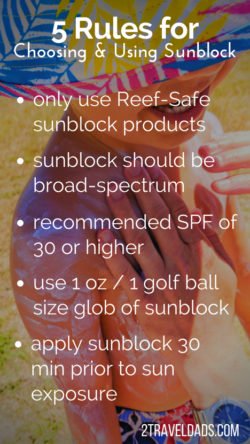
Reef-safe sunblock choices – we start here because this is extremely important to us. Sunblock is a chemical compound (as is tanning oil) and you don’t want that going into the ocean to be ingested by fish and other creatures. Choose a sunblock product that calls out its reef-safe nature and avoid products with oxybenzone and octinoxate. Also, if you’re using a tanning oil of some sort, be kind to the earth and don’t go swimming in the ocean or lake.
Broad spectrum sun block– this means that it protects against UV A + B rays. The UVA rays can cause premature aging, wrinkles, and damage that can lead to skin cancer. The UVB rays can cause your skin to burn.
SPF – the sun protection factor refers to how well the product is supposed to block the UVB rays to prevent burning. The accepted recommendation is that a minimum of 30 SPF be used.
Sun block amount – of course the size of the person is going to impact this, but for an average sized person it’s about 1 oz per application (a golf ball sized glob) **wearing a bit more clothing reduces the amount you need to apply
When to apply sun protection – sun block should be applied 30 minutes prior to being out in the sunshine to allow it to set. As the day goes on, reapplying every two hours or sooner is recommended.
Remember, we always are referring to your doctor for recommendation about any sort of product you apply to your body or ingest, and that goes for sunblock too. If you have small children, confirm with their pediatrician when it’s appropriate to start using sunblock, as it’s not typically recommended to be used younger than six months.
How to make applying sunblock easier
Ha ha ha! I’m so glad we don’t have to deal with squirmy sunblock moments anymore. As our kids have gotten older and we’ve worked in more thoughtful practices to limit sun exposure, we’ve had to apply sun block less and less. With that though, there still are times we choose to use it.
To make it easier to apply sunblock, or any sort of product, to a child’s skin, get them involved in the process. This both educates them about sun protection and gives them something to do besides fidget. Let your kids apply to their legs, arms and tummy, while you do the shoulders, chest, back and neck. For applying sunblock to the face NEVER spray it on, but spray into your hands and then carefully apply to the skin. And be sure if you’re using a spray sun protection that nobody breathes it in. Chemicals, right?
We hope this is all very helpful and provides some good options for sun protection for you and your family. Everybody manages their health differently, but I think we can all agree that sunburns and sun damage isn’t fun. For more information about sun protection and also sun burn treatment tips, consult your physician and do you own research on current studies and the most up-to-date sun protection information.


